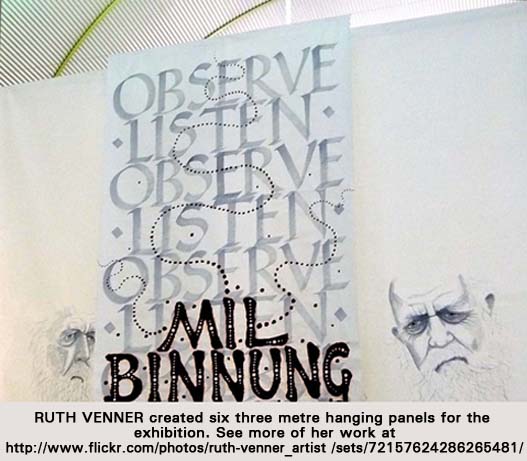KASAMA Vol. 24 No. 3 / July-August-September 2010 / Solidarity Philippines Australia Network
The text of one of the display panels in the exhibition MIL BINNUNG - OBSERVE LISTEN
Where are all the people from Mulgumpin?
Observant visitors to Mulgumpin will find ample and rich evidence of human activity, some dating back at least 20,000 years, some only a hundred or so years. Pathways, middens, residential areas, quarries and ceremonial sites can all be found. Visitors will then inevitably ask: “Where are the people who obviously lived here? What happened to them?”
This is what happened to them, according to one of the “Croppies” or convicts and recorded by J. J. Knight in 1892:

By J. J. KNIGHT, in the “QUEENSLANDER” dated 1892
Who Were the Aggressors?
The mention of Chief-constable McIntosh's name reminds the writer a few of incidents related to him by an "old hand." This is what he said: - "What did I think of Dunwich? Well, we used to think we were well off if we could get down there, for as a rule we got better treatment and easier times. Then the blacks were a very civil lot on Stradbroke, and would do lots of things for us for a few rations. There were two kings there - one at each end of the island - the one at our end, Amity, being a bit independent, but one who would do no one harm. Somehow - I think it must have been because he would not receive food or gifts from them - the soldiers got frightened of him.
One day some of the soldiers made it up to go fishing on Moreton Island, and persuaded the king to go with them. After some difficulty they got him in the boat, and had gone some little distance out when one of the soldiers drew out a pistol and shot the blackfellow. The hutkeeper, who was with the soldiers, cut off the poor fellow's head, and this was sent on to Brisbane to show the Commandant that they had been successful in shooting a desperate blackfellow. Well, the blacks weren't long before they heard all about it, and they watched the hutkeeper. They seized the first opportunity that presented itself to attack this man and decapitated him. The soldiers of course were mad, and searched for the blackfellows, but finding none they set out one night for Moreton Island and shot every blackfellow they came across. How many did they come across? As near as I can remember there were between fifteen and twenty.
Nothing further was heard for awhile, but the blacks vowed they would kill every 'diamond' - that was the name we gave the soldiers, you know. Some time afterwards Chief-constable McIntosh and two men were sent out to hunt for runaway prisoners. They were unsuccessful in their search, however, and were returning along the beach when a mob of blackfellows attacked the chief constable and his men, killing the three. By Jove! There were ructions over this. A detachment of military was sent out to Point Lookout, which was the great fishing ground of the aboriginals, with instructions to shoot every black that was met with. Well, the blacks somehow got wind of this, and one night some of them came to us at the Pilot Station and told us not to go with the "diamonds" in the pilot boat, because they intended fighting, and did not want to hunt the 'croppies' - that was our name. But you know some of us had to go, and I'm glad to say I wasn’t one of those chosen for the job, for it was a terrible fight, in which the soldiers got the worst, and three of our men were among those killed.
After things had quietened down a bit the blacks came about again, and I can't tell you how sorrowful they were when they were told they had killed some of the 'croppies.' It's all rot to say the blacks were of a treacherous nature. It was the other way about; if the soldiers had done the right thing by them, as the majority of the convicts did, there wouldn't have been any trouble at all."
After the massacre, two of the survivors were found and removed to Minjerribah. One was Wyneeaba Murriaba Kingal, a child of three, Robert Anderson’s great grandmother.

Related Article:
An online edition of
"History, Life and Times of Robert Anderson" has been reformatted by Inkahoots in co-operation with Robert Anderson and editing by Cathy Boyle. It includes updates of recent developments and photographs. You can download the online edition at
http://www.colourise.com.au/docs/History Life & Times.pdf


 Home | Aims and Objectives of Solidarity Philippines Australia Network | About Kasama
Home | Aims and Objectives of Solidarity Philippines Australia Network | About Kasama 